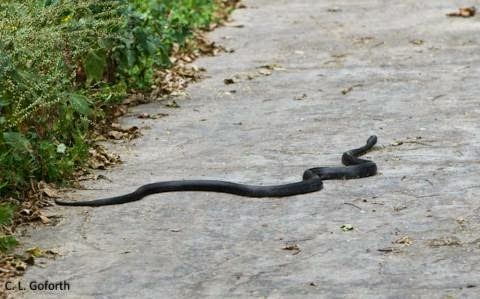While you’re out looking for (or avoiding) skunk cabbage,
there might be one other creature to avoid stepping on. If you want to keep
your toes and other small appendages safe, keep your eyes peeled for snapping
turtles! The Common Snapping Turtle lives throughout North America, though they
are seen less in higher altitudes, such as the Rocky Mountains, and can be
found in lakes, ponds, and slow moving rivers or creeks. Despite the myths
surrounding these majestic beasts, it is very unlikely that you will lose a
finger or toe to a Snapping Turtle bite. They can exert about the same amount
of pressure as humans, so it is possible, but not common. A bite from a
Snapping Turtle is not to be underestimated, though. They have been known to
eat other turtles, shell included. Snapping Turtles eat a lot of different
types of things, actually. The great reptiles eat fish, birds, mammals, other
reptiles, carrion (dead meat, think roadkill), amphibians, and almost a third
of their diet consists of plant matter. This is a fairly diverse diet, and it
can basically be summed up in ‘they eat whatever they can find in their habitat
and fit in their mouths, or that they are able to rip apart.’ These
pre-historic reptiles have walked this earth as long ago as the dinosaurs, and
just looking at them, you can tell.
(Also curtesy of http://a-z-animals.com/animals/snapping-turtle/)
The Common Snapping Turtle ranges from black to brown in
coloration, although the bottom of their shells and bodies is usually closer to
yellow. There are about three rows of plates that stretch from head to tail.
The back of the carapace (a fancy name for the top half of the shell) has sharp
ridges on it to help discourage predators from trying to sneak up behind the
turtle. A Snapping Turtle’s tail is usually very long, about as long as its
upper shell, actually (which can grow to be more than a foot long), and has a
row of serrated scales going down it. The tail happens to be an extension of
the turtle’s vertebrae, so it is never a good idea to pick up a turtle by its
tail because you can do a lot of damage to it. If you absolutely have to pick
up a Snapping Turtle, pick it up by its back feet. As long as you hold it away
from your body and don’t drop it, you will not damage the turtle and it will
not damage you. I would suggest avoiding picking up a Snapping Turtle, though;
it won’t like it, and I doubt you would enjoy being picked up by some big scary
creature, either. Besides, Snapping Turtles have pretty sharp claws and
powerful legs for swimming and digging, so it’s best to avoid a nasty scratch
and just leave the quiet giant alone. They will most likely ignore you unless
they feel threatened (which is when they start SNAPping!!). The bottom half of a Snapper’s shell is rather small,
which allows the turtle to have a greater mobility in its legs as well as more
muscle to move rocks and dirt, which is very helpful for females.
(This picture was found
by https://nicksnaturepics.wordpress.com/tag/snapping-turtle/)
Female Snapping Turtles will get the urge to travel landside
when they are ready to lay their eggs. This happens anytime between April and
November, and female Snappers have been known to travel more than twelve miles
until they find a suitable nesting area. They will dig a shallow hole into the
earth in a sunny, well drained area, lay between twenty and forty small,
spherical eggs, and then leave the eggs to fend for themselves and return to
the water. The following summer (usually between May and June), the eggs (which
resemble ping-pong balls) will hatch, and baby Snapping Turtles will follow
their instincts and travel to the nearest lake, pond, or slow river. Sadly,
only about ten percent of the nests make it to the ‘hatching’ stage because
predators, such as raccoons, will dig them up and eat the eggs if they can find
the nest. However, once the baby Snappers make it to the water and their shells
have some time to harden, they will be prey to very few predators for the rest
of their lives.
(This picture was
taken by me)
Snapping Turtles usually live for more than forty years and
can grow to fairly impressive sizes in that time. We currently have three
Snapping Turtles here at GNC: two babies that hatched this past October and a
juvenile who is a year-and-a-half to two years old. To help give you an idea of
what these little guys can grow into, I took a few comparison pictures with one
of the babies and the full-sized carapace that we have.
(In case you didn’t
notice, these were all taken with my phone. *Insert winky face* )
Pretty cool, right? If you want to
see them in person, stop by the Nature Center sometime; they’re pretty cute. :) If
you have any pictures of snapping turtles, or a neat story that you would like
to share, just send me an email at gncintern@gmail.com
and I’ll include it in a follow-up post! Now, go enjoy this nice weather!!
Thank you for reading!
-Connie
Information found at: http://animals.pawnation.com/jaw-pressure-snapping-turtle-4411.html






















